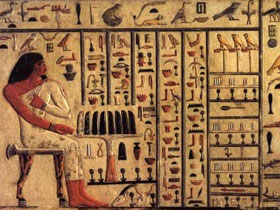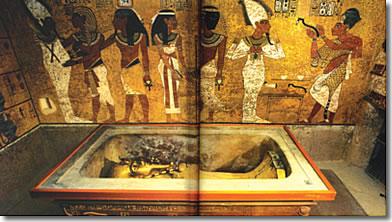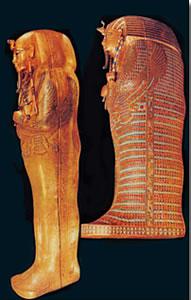Ancient Egypt is one of the most magnificent civilizations founded by man thousands of years ago. The Ancient Egyptians attained very high levels of medicine, science and art, and left hundreds of works behind them. They possessed more knowledge and experience than would have been possible were they the continuation of a primitive society. The levels achieved by the Egyptians have still not been achieved in many parts of the world today. In various parts of Africa, certain regions of South America, and various parts of Asia, and even in Egypt itself, a life way beyond the general level of civilization is still led. The civilization of Ancient Egypt, which registered such great successes in medicine, especially anatomy, urban planning, architecture, fine arts and textiles, is today studied by scientists with great awe and amazement.
The Origin of Medicine in Ancient Egypt
The level of development achieved by medicine in Ancient Egypt is quite amazing. Findings obtained from excavations have amazed both archaeologists and many historians because no historian expected such a highly developed technology in a civilization that existed in the 3000s BC.
It has been revealed, using X-ray analysis of mummies, that brain surgery was performed in Ancient Egypt. i What is more, these operations were carried out using highly professional techniques. When mummy skulls that underwent surgery are examined it can be seen that the sites of the surgery have been cut very neatly. Skull bones that have fused back together have been found, proving that these people survived after such operations. ii
Another example concerns various medicines. Giant strides were made in medicine in the 19th century due to the rapid progress made in experimental science. The discovery of antibiotics was one of the greatest advances made in that century. Yet the word “discovery” is not strictly accurate, because many of these techniques had already been known to the Ancient Egyptians. iii
One of the most important works showing just how advanced the Egyptians were in science and anatomy is without doubt the mummies they left behind them. The Egyptians used hundreds of different techniques in the process of mummification.
The mummification process that permits the bodies of living things to be preserved for thousands of years is actually a highly complex one. In essence, the technique employed by the Egyptians is this:
Firstly, the brain and some of the internal organs of the deceased were removed using special instruments. The next stage in the mummification procedure involved dehydrating the body for 40 days with natron. (Natron is a mineral salt, primarily a mixture of sodium bicarbonate and sodium carbonate with small amounts of sodium chloride and sodium sulfate.) The excess body fluids were drained away and then the body cavity was stuffed with linen, sand or sawdust. The skin was anointed with special herbal preparations and then coated with molten resin to further preserve it. Finally the body was carefully wrapped in linen bandages. iv
The Egyptians’ mummification techniques were applied not only to human beings but also to animals. Archaeological findings and mummification techniques in particular show that medicine in Ancient Egypt was highly advanced. In addition, it must not be forgotten that mummification, carried out without damaging the shape of the body and by extracting all the deceased’s internal organs, shows that the people who performed it possessed a sufficient knowledge of anatomy to know to position of all the various organs.
Many medical techniques and implements used by the Egyptians 5000 years ago apart from for mummification have also been unearthed during excavations. The details of these may be listed as follows:
- The priests involved in medicine in Egypt treated all kinds of disease in their temples. Just as today, Egyptian doctors specialized in various fields of medicine. Every doctor had his own branch. Expert physicians in provided services, from eye doctors to dentists.
- Doctors in Egypt were supervised by the state. If the patient failed to recover or died, the state would investigate the reasons and determine whether or not the method of treatment employed by the doctor conformed to the rules. If any oversight had taken place during treatment this was identified and doctors punished within the framework of the law.
- Every temple possessed a well-equipped laboratory in which medicines were prepared and stored.
- The first steps in pharmacology and examples of the use of bandages and compresses go back to Ancient Egyptian times. The Smith Papyrus described how adhesive strips made out of linen were used to heal wounds. Linen was also an ideal material for making bandages.
- Archaeological findings have revealed a detailed picture of medical practices. In addition, the names and titles of more than 100 doctors specializing in their own fields have been discovered.
- A cavity was made in a relief on the wall of another temple in Kom Ombo and a box of surgical instruments placed inside it. This box contained a pair of large metal scissors, surgical knives, saws, probes, spatulas, small hooks and pincers.
- The techniques employed were numerous and varied. Breaks and fractures were set together, splints employed and wounds closed up with stitches. Breaks treated with great success can be found in most mummies.
- Although no trace of surgical sutures has been found in mummies there are 13 references to wound suturing in the Smith Papyrus (which is wholly concerned with medicine). This indicates that the Egyptians managed proper wound suturing, in which a linen thread was employed. The needles were in all probability made out of copper.
- Egyptian doctors were able to distinguish between sterile wounds and infected ones. They used a mixture of goat fat, fir oil and crushed peas to clean infected wounds.
- The discovery of penicillin and antibiotics was made relatively recently. However, the Ancient Egyptians used the first organic versions of these therapies. In addition, the Egyptians were familiar with different types of antibiotic. They wrote prescriptions suited to various types of disease. v
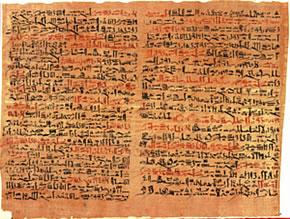 The Papyrus Smith |
As we have seen, Egyptian civilization took major strides forward in the field of medicine, developing methods of treatment and training expert doctors. In addition to these successes in medicine, excavations have also revealed that the Egyptians were very interested in such subjects as urban planning and architecture.
An Advanced Level of Mathematics
Numbers were used in Ancient Egypt from very early times. Papyruses from 2000 BC that describe mathematical problems have been found. These documents are known as the Kahun, Berlin and Rhind papyruses. These documents state, with examples, the bases on which measurements are made. The Egyptians made use of Pythagorus’s Theorem, and knew that a triangle whose sides measure 3-4-5 is a right-angle triangle, in their construction measurements. vi
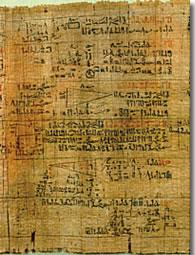 The Papyrus Rhind |
In addition, the Egyptians knew the difference between planets and stars. They added the stars, which are very hard to see, to their studies of astronomy.
On the other hand, since the Egyptians’ lives were dependent on the rising and falling of the Nile, they constantly had to measure and check it. Their ruler had a “Nilometer” made to record the rise and fall of the waters of the Nile, and appointed officials for the purpose.vii
The Egyptians’ knowledge of medicine, urban planning, and engineering and how it should be put into practice are just a few of the proofs that they possessed an exceptionally advanced civilization. This knowledge and the measures they implemented once again overturn the thesis, advocated by evolutionists, that “societies progress from a primitive state to a civilized one.” A society that existed 5000 years ago possessed a more advanced level of civilization than some communities living in the same place in our own day: that is something that cannot be explained in terms of evolution. There is also no doubt that at the time when the Egyptians were enjoying that advanced civilization there were more backward civilizations and people living in more primitive conditions in other parts of the world. Yet none of these had any less-then-human- features, nor any supposedly ape-like ones. The Ancient Egyptians, other people living in primitive conditions at the same period as them and human communities that existed hundreds of thousands of years ago, as well as modern man, have all been entirely human in all respects. Some communities may have lived in more advanced conditions and others in more backward ones, but this does not show, as Darwinists maintain, that they are a species descended from animals or that one group evolved from another. Such an interpretation is a violation of reason and logic.
To purchase the works of Harun Yahya, please visit www.bookglobal.net
i Moustafa Gadalla, Historical Deception: The Untold Story of Ancient Egypt, Bastet Publishing, Erie, Pa., USA, 1996, pp. 295, 296.
ii Interview with Dr. Zahi Hawass, Director of the Pyramids, http://www.pbs.org/wgbh/nova/pyramid/excavation/hawass.html
iii Gadalla, Historical Deception, p. 296
iv http://www.amonline.net.au/teachers_resources/background/ancient_egypt04.htm
v Afet İnan, Eski Mısır Tarihi ve Medeniyet, Türk Tarih Kurumu Basımevi, Ankara: 1956, p. 318.
vi Gadalla, Historical Deception, p. 311.
vii Baines and Malek, Eski Mısır, p. 69.

